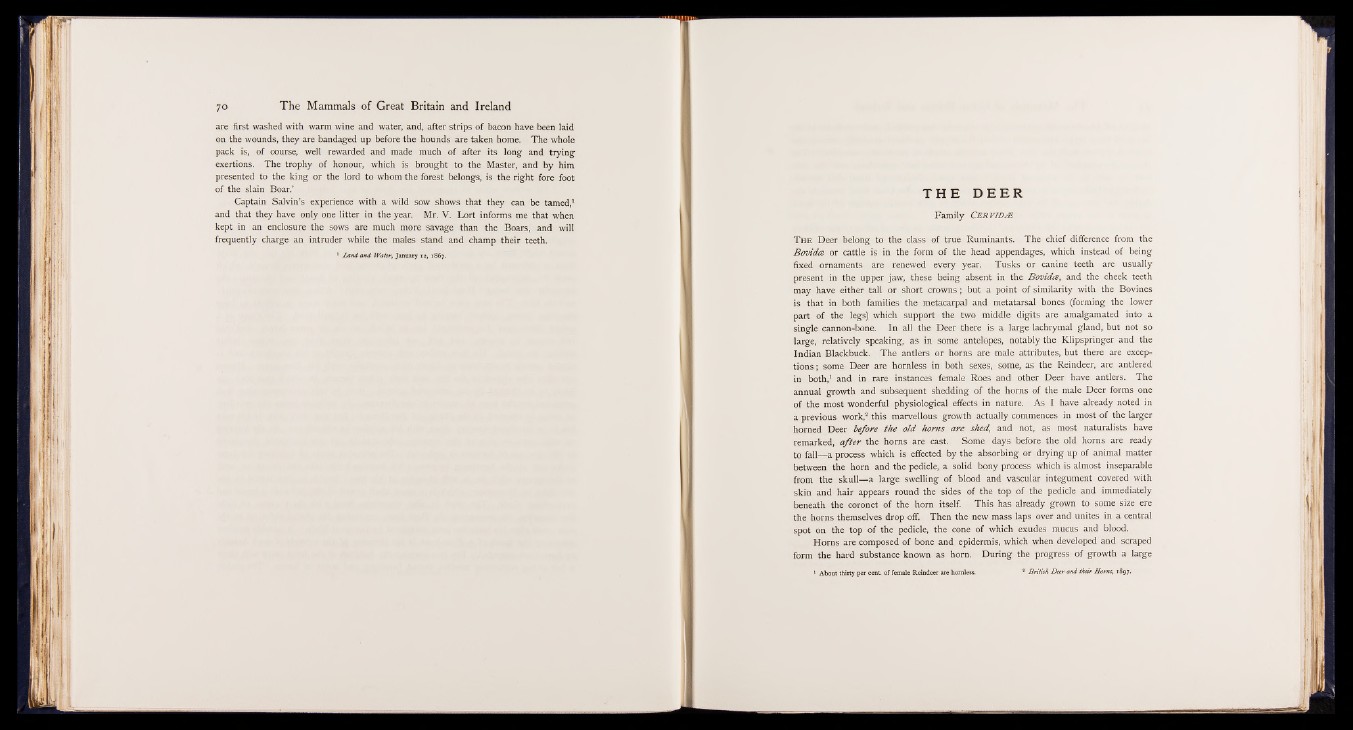
are first washed with warm wine and water, and, after strips of bacon have been laid
on the wounds, they are bandaged up before the hounds are taken home. The whole
pack is, of course, well rewarded and made much of after its long and trying
exertions. The trophy of honour, which is brought to the Master, and by him
presented to the king or the lord to whom the forest belongs, is the right fore foot
of the slain Boar.’
Captain Salvin’s experience with a wild sow shows that they can be tamed,1
and that they have only one litter in the year. Mr. V. Lort informs me that when
kept in an enclosure the sows are much more savage than the Boars, and will
frequently charge an intruder while the males stand and champ their teeth.
Land and Water, January 12, 1867.
THE DEER
Family CER V ID JE
T h e Deer belong to the class of true Ruminants. The chief difference from the
Bovidce or cattle is in the form of the head appendages, which instead of being
fixed ornaments are renewed every year. Tusks or canine teeth are usually
present in the upper jaw, these being absent in the Bovidce, and the cheek teeth
may have either tall or short crowns ; but a point of similarity with the Bovines
is that in both families the metacarpal and metatarsal bones (forming the lower
part of the legs) which support the two middle digits are amalgamated into a
single cannon-bone. In all the Deer there is a large lachrymal gland, but not so
large, relatively speaking, as in some antelopes, notably the Klipspringer and the
Indian Blackbuck. The antlers or horns are male attributes, but there are exceptions
; some Deer are hornless in both sexes, some, as the Reindeer, are antlered
in both,1 and in rare instances female Roes and other Deer have antlers. The
annual growth and subsequent shedding of the horns of the male Deer forms one
of the most wonderful physiological effects in nature. As I have already noted in
a previous work,2 this marvellous growth actually commences in most of the larger
horned Deer before the old horns are shed’ and not, as most naturalists have
remarked, after the horns are cast. Some days before the old horns are ready
to fall— a process which is effected by the absorbing or drying up of animal matter
between the horn and the pedicle, a solid bony process which is almost inseparable
from the skull— a large swelling of blood and vascular integument covered with
skin and hair appears round the sides of the top of the pedicle and immediately
beneath the coronet of the horn itself. This has already grown to some size ere
the horns themselves drop off. Then the new mass laps over and unites in a central
spot on the top of the pedicle, the cone of which exudes mucus and blood.
Horns are composed of bone and epidermis, which when developed and scraped
form the hard substance known as horn. During the progress of growth a large
About thirty per cent, of female Reindeer are hornless. British Deer and their Homs, 1897.